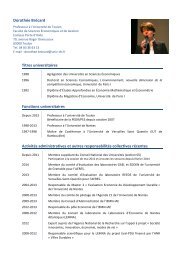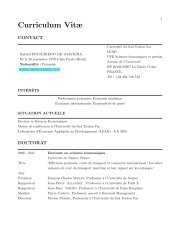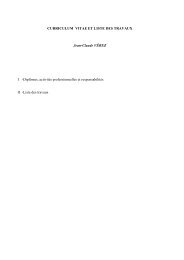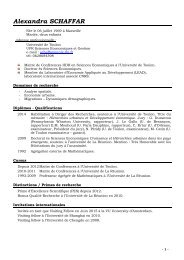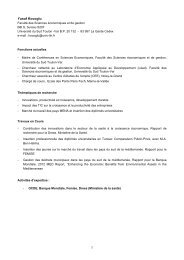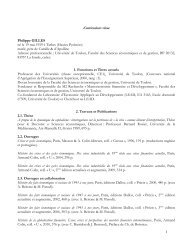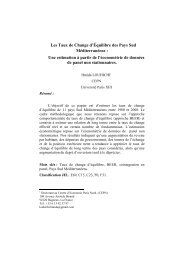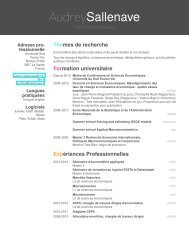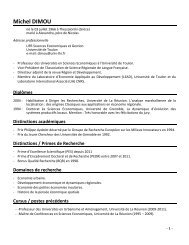The determinants of the number of banks: Empirical results ... - LEAD
The determinants of the number of banks: Empirical results ... - LEAD
The determinants of the number of banks: Empirical results ... - LEAD
Create successful ePaper yourself
Turn your PDF publications into a flip-book with our unique Google optimized e-Paper software.
for Economic Analysis) edited by Bureau Van Dijk. We also sent a questionnaire byelectronic mail to several Small and Medium Business stemming from <strong>the</strong> same Frenchdatabase, to collect a qualitative data. Next, we present an econometric analysis. Section 4presents econometric <strong>results</strong>. Finally, in section 5 we summarize and conclude.II.Review <strong>of</strong> literatureAccording to <strong>the</strong> financial intermediation <strong>the</strong>ory, we distinguished between two types <strong>of</strong>bank financing: single bank relationship and multiple bank lending. Single banking hasgenerally been considered as beneficial for Small and Medium Business because itfacilitates efficient usages <strong>of</strong> loans; it‟s based on cost minimization. This kind <strong>of</strong> firms,are known to be very opaque, may find it difficult to credibly signal <strong>the</strong>ir quality in orderto access <strong>the</strong> capital markets. A bank can solve this problem <strong>of</strong> information asymmetry bycreating information. In that sense, a bank acquires through time private information about<strong>the</strong> firm, leading to an informational advantage (Fama, 1985). Much <strong>of</strong> this information isobtained in <strong>the</strong> subsequent monitoring role that is <strong>of</strong>ten seen as a defining characteristic <strong>of</strong>bank financing (Diamond, 1984). It thus appears that a single bank relationship reduceinformation asymmetry and credit rationing. <strong>The</strong>se elements enable to formulate <strong>the</strong> firsthypo<strong>the</strong>ses to test: <strong>the</strong> most informational opaque firms should be characterized by areduced <strong>number</strong> <strong>of</strong> <strong>banks</strong>.However, this private information about firms, allows <strong>banks</strong> to accrue monopoly power.Information asymmetries about <strong>the</strong> firm‟s quality credit prevent o<strong>the</strong>r <strong>banks</strong> fromidentifying <strong>the</strong> real type <strong>of</strong> each borrower (Sharpe, 1990). Indeed, firm with single bankrelationship may be informationally captured by its bank. This hold-up problem allowsbank to extract rents from <strong>the</strong> firm and makes credit costly, but it can present an advantagein terms <strong>of</strong> credit availability for firms. To limit a single bank‟s ability to extract rents,one <strong>of</strong> solution is <strong>the</strong> diversification <strong>of</strong> financing sources (Rajan, 1992). In fact,competition among <strong>banks</strong> reduces <strong>the</strong> adverse effects <strong>of</strong> <strong>the</strong> hold-up problem. <strong>The</strong>nhypo<strong>the</strong>sis n°2 is that: <strong>number</strong> <strong>of</strong> <strong>banks</strong> increases with <strong>the</strong> duration <strong>of</strong> bankingrelationship.Moreover, multiple bank lending relationships protect firm from an illiquidity risk <strong>of</strong>banking origin (Detragiache et al., 2000). <strong>The</strong> SMB and those have a single bankingrelationship are strongly exposed to adverse selection. So, if <strong>the</strong> informed bank cannotrenew <strong>the</strong> initial loan, <strong>the</strong> firm in liquidity need has to apply for loans from non-informed






